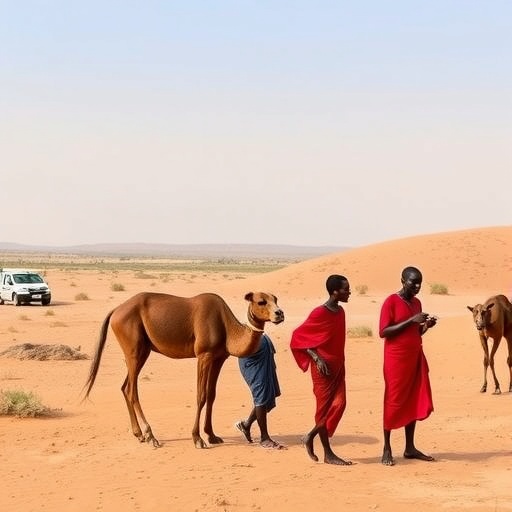In an unprecedented collaboration bridging continents and cultures, researchers from the United States and Kenya have unveiled groundbreaking insights into the genetic adaptations that have enabled the Turkana people of northern Kenya to survive—and indeed thrive—in one of the harshest environments on Earth. This comprehensive genomic study, recently published in Science, offers a window into the deep evolutionary responses that have shaped human resilience to extreme aridity, water scarcity, and the demanding lifestyle of pastoralism in semi-desert landscapes.
The Turkana inhabit the Turkana Basin, an expansive parcel of land characterized by intense heat, minimal shade, and critically limited water availability. Their way of life has revolved around nomadic pastoralism for millennia, requiring them to navigate vast and unforgiving terrains while sustaining themselves and their herds of goats and camels. This lifestyle has historically demanded remarkable physiological and metabolic adaptations to counteract dehydration and nutritional challenges intrinsic to desert survival.
Through decades of fieldwork involving ethnographic observations and biomedical assessments—including blood and urine analyses—the scientists identified a paradox within the Turkana population: despite profound and chronic dehydration indicators in approximately 90% of individuals, the community displayed robust general health and resilience. This paradox signaled underlying biological mechanisms shaped by natural selection, capable of mitigating the severe risks posed by their environment.
The core of the genomic investigation stemmed from inclusive engagement with local Turkana leaders and health officials, ensuring ethical sample collection and community partnership. Researchers sequenced 367 whole genomes, analyzing over seven million genetic variants to unearth loci subjected to positive selection pressures. Among eight regions displaying signatures of adaptation, one gene, STC1 (stanniocalcin 1), emerged as a compelling candidate driving key adaptive traits associated with water conservation and renal protection.
STC1 encodes a hormone primarily active in kidney tissues, facilitating physiological responses that enhance water retention. Specifically, it modulates renal sensitivity to antidiuretic hormone, enabling the Turkana to concentrate urine effectively and reduce water loss. Moreover, STC1 may offer cytoprotective functions by mitigating nephrotoxic effects arising from high dietary intake of purine-rich animal products—such as meat and blood—that can produce harmful filtered waste like uric acid and urea. This protective role likely contributes to the notably low incidence of gout and related renal ailments within the Turkana, despite their protein-heavy nomadic diet.
Paleoclimatic reconstructions indicate that the Turkana region underwent significant aridification approximately 5,000 years ago, coinciding temporally with the emergence of these adaptive genetic variants. This synchronicity strongly implicates climatic stressors as drivers of human evolutionary change, where natural selection favored alleles promoting survival in increasingly desertified habitats. The study also revealed that similar genetic adaptations are shared among neighboring pastoral groups, such as the Rendille, underscoring convergent evolution within arid East African populations.
Intriguingly, the adaptive story takes a modern twist as rising urbanization introduces new environmental contexts for the Turkana. As segments of the population transition from rural pastoralism to urban lifestyles, the very genes that once safeguarded survival now predispose individuals to chronic metabolic disorders—an instance of evolutionary mismatch. Genetic and biomarker analyses comparing urban and rural Turkana revealed altered gene expression patterns associated with higher incidences of hypertension, obesity, and related cardiometabolic conditions in city dwellers.
This shift highlights the complex interplay between ancient adaptations and contemporary environmental changes. The divergence in diet, physical activity, and water access inherent to urban living disrupts previously advantageous genetic programs, precipitating increased disease susceptibility. Health leaders from the Kenya Medical Research Institute emphasize the urgency of integrating genetic insights into public health strategies tailored for transitioning populations.
The Turkana Health and Genomics Project (THGP), underpinning this research, exemplifies a paradigm of collaborative science rooted in respect and mutual knowledge exchange. From initial discussions arcing over campfires with elders and community members, the project has fostered a co-production of knowledge, blending genomic data with cultural and ecological expertise. This inclusive framework ensures that findings remain grounded in the lived realities of the Turkana, enhancing both scientific rigor and community relevance.
Looking forward, the research team is developing educational tools, including a podcast delivered in the Turkana language, to disseminate study insights locally. These resources aim to empower communities with practical health guidance amid rapid lifestyle transitions, preserving cultural context while addressing emerging public health challenges. Furthermore, the findings resonate with other pastoralist groups in East Africa who face analogous environmental pressures, suggesting broader applicability and significance.
In the global context of accelerating climate change and increasing human mobility, the Turkana case study offers vital lessons on the capacity for genetic adaptation to extreme environments and the vulnerabilities introduced by rapid socio-ecological shifts. Their story underscores the need for integrative approaches that combine evolutionary biology, anthropology, and public health to better anticipate and manage the health trajectories of indigenous and transitioning populations worldwide.
By centering indigenous voices and emphasizing ethical collaboration, this study repositions sub-Saharan Africa—notably the Turkana—as a critical locus in the field of genomic research. It challenges historical underrepresentation and illustrates how studying diverse human populations enriches our understanding of biology, evolution, and disease. The insights gained from the Turkana elevate our comprehension of human adaptability and provide a blueprint for navigating the complex intersections of genetics, environment, and culture in an ever-changing world.
As the pressure mounts on ecosystems globally, the adaptive strategies honed by the Turkana over thousands of years exemplify resilience par excellence, while simultaneously cautioning against the unintended health consequences of modern lifestyle changes. These findings not only expand the frontiers of evolutionary genomics but also illuminate new pathways toward supporting health and survival amidst unprecedented environmental transformation.
Subject of Research: People
Article Title: Adaptations to water stress and pastoralism in the Turkana of northwest Kenya
News Publication Date: 18-Sep-2025
Web References: DOI: 10.1126/science.adv2467
Image Credits: Julien Ayoles/UC Berkeley
Keywords: Turkana, genomic adaptation, water stress, pastoralism, natural selection, evolutionary mismatch, kidney genetics, STC1, arid environment, East Africa, urbanization, chronic disease




